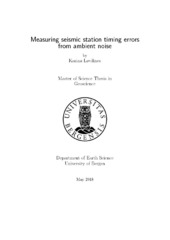Measuring seismic station timing errors from ambient noise
Master thesis
Permanent lenke
https://hdl.handle.net/1956/18942Utgivelsesdato
2018Metadata
Vis full innførselSamlinger
- Department of Earth Science [1050]
Sammendrag
Cross correlations of ambient seismic noise recorded at two stations can be used to estimate the Green’s function between these two stations. Since seismic stations are continuously recoding seismic noise, the Green’s function can be used to monitor the stability of a network of stations. The Green’s function is the impulse response of the structure, and changes occurring in the structure will therefore affect the shape of the Green’s function. However, variations in the Green’s function can also be caused by changes in noise distribution and instrumental errors. In this thesis, techniques, similar to those used for monitoring velocity changes in the structure, are applied on ambient seismic noise to find instrumental timing errors. There are several steps between seismic noise and the Green's function, and the processing procedure is therefore divided into four main parts: preparing the data, preprocessing, cross correlation and stacking, and measuring the timing errors. A detailed description of the different parts is given and the limitations of the method are examined. The method is applied to noise recorded on stations from the temporary Norwegian network NEONOR2, that was located in northern Norway.
